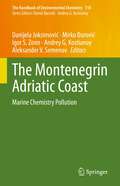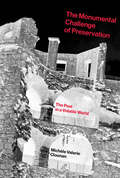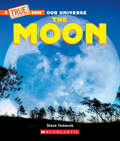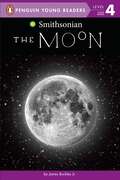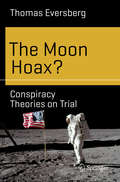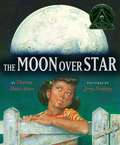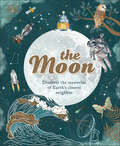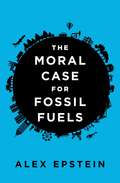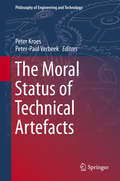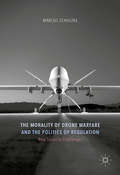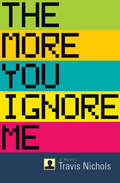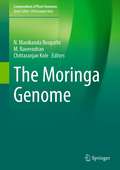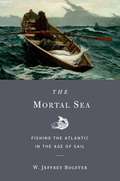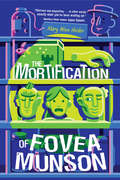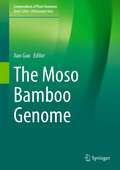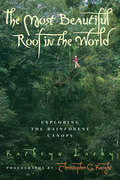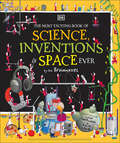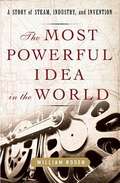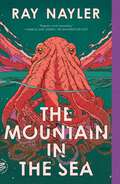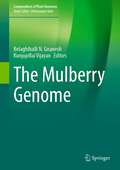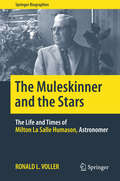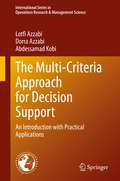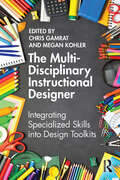- Table View
- List View
The Montenegrin Adriatic Coast: Marine Chemistry Pollution (The Handbook of Environmental Chemistry #110)
by Andrey G. Kostianoy Igor S. Zonn Aleksander V. Semenov Mirko Đurović Danijela JoksimovićThis is the second of two volumes that together provide an integrated picture of the Montenegrin Adriatic coast, presenting the natural components of the system as well as the chemical composition and chemical processes in the extended area. This book covers all aspects of marine chemistry such as the hydrographic and oceanographic characteristics of seawater, the toxicity of heavy metals in the marine environment, the quality of marinas and maritime areas, and the legal regime for protecting the marine environment from pollution. Given the breadth and depth of its coverage, the book offers an invaluable source of information for researchers, students and environmental managers alike.
The Monumental Challenge of Preservation: The Past in a Volatile World (The\mit Press Ser.)
by Michele Valerie CloonanThe enormous task of preserving the world's heritage in the face of war, natural disaster, vandalism, neglect, and technical obsolescence.The monuments—movable, immovable, tangible, and intangible—of the world's shared cultural heritage are at risk. War, terrorism, natural disaster, vandalism, and neglect make the work of preservation a greater challenge than it has been since World War II. In The Monumental Challenge of Preservation Michèle Cloonan makes the case that, at this critical juncture, we must consider preservation in the broadest possible contexts. Preservation requires the efforts of an increasing number of stakeholders.In order to explore the cultural, political, technological, economic, and ethical dimensions of preservation, Cloonan examines particular monuments and their preservation dilemmas. The massive Bamiyan Buddhas, blown up by the Taliban in 2001, are still the subject of debates over how, or whether, to preserve what remains, and the U. S. National Park Service has undertaken the complex task of preserving the symbolic and often ephemeral objects that visitors leave at the Vietnam Veterans Memorial—to take just two of the many examples described in the book. Cloonan also considers the ongoing genocide and cultural genocide in Syria; the challenges of preserving our digital heritage; the dynamic between original and copy; efforts to preserve the papers and architectural fragments of the architect Louis Sullivan; and the possibility of sustainable preservation. In the end, Cloonan suggests, we are what we preserve—and don't preserve. Every day we make preservation decisions, individually and collectively, that have longer-term ramifications than we might expect.
The Moon (A True Book (Relaunch))
by Steve TomecekDid you know the moon is considered a natural satellite? Or that its gravity affects ocean tides on Earth? This book explores the closest celestial body to Earth and the ways in which the moon and Earth affect each other.Chapters introduce topics including the moon's origin, its makeup and phases, the first people to walk on its surface, and the moon's role in both lunar and solar eclipses.Planets and stars, moons and galaxies! The universe is a vast and mysterious place with much to explore. And there's no better way to make amazing discoveries about space than with this reimagined series. With the latest NASA imagery, the classic structure and features of A True Book, and lively text, the titles in Our Universe bring the awe of the cosmos directly to readers. Students will come away with a wealth of knowledge about the incredible celestial bodies in our universe.This series covers Next Generation Science Standards core ideas including "The Universe and its stars" and "Earth and the solar system."
The Moon (Smithsonian)
by James BuckleyCheck out the moon—in all its phases—in this new Level 4 Penguin-Smithsonian nonfiction reader.There are myths about it. Men have landed on it. Just about everybody has gazed at it in wonder. But what is the moon? Where did it come from? What&’s it made of? Find out in this lively reader about the celestial body that&’s so familiar and yet so mysterious.
The Moon Hoax?: Conspiracy Theories on Trial (Science and Fiction)
by Thomas EversbergThis book is about the American moon-landings – and about the doubts expressed ever since concerning the reality of these landings. Were the images of men on the moon really just a huge and cleverly executed hoax? Eversberg explains the best-known claims and conspiracy theories, and analyzes the evidence with the help of detailed full-colour images, as well as numerous film documents that can be accessed directly from the book. He addresses both the persistent older claims and more recently devised doubts. The book will inform and entertain a wide range of readers interested in space exploration and tells a gripping story covering physics, politics and history.
The Moon over Star
by Dianna Hutts AstonOn her family's farm in the town of Star, eight-year-old Mae eagerly follows the progress of the 1969 Apollo 11 flight and moon landing and dreams that she might one day be an astronaut, too.
The Moon: Discover the Mysteries of Earth's Closest Neighbour (Space Explorers)
by Dr. Sanlyn Buxner Pamela Gay Georgiana KramerDiscover the mysteries of Earth&’s closest neighbor in this incredible guide to the Moon. This charming book is the perfect introduction for young readers who want to learn about every aspect of the moon. The Moon features breakdowns of the Moon&’s formation and geography, the lunar phases, a history of NASA&’s Apollo missions, the Moon&’s effect on Earth&’s tides and nocturnal animals, recent scientific discoveries, and so much more!This fascinating guide introduces 7-9 year olds to the moon&’s past, present, and future, through stunning illustrations, photographs, and fascinating information. Packed with mind-blowing facts, this incredible book of the moon is perfect for space lovers everywhere. Explore this wonderful book about the moon, featuring:- In-depth information, backed up by space photography, probe images, illustrations, and fun diagrams- Stunning, dreamy illustrations, making this title a perfect gift, as well as a solid reference book - Easy-to-digest sections, each filled with incredible facts and visuals- The entire subject of the Moon – including its formation and geography, the lunar phases, a history of NASA&’s Apollo missions, its effect on Earth&’s tides and nocturnal animals, plenty of recent scientific discoveries, and more!Boasting beautiful illustrations by artist Dawn Cooper, combined with up-to-date images from space agencies such as NASA and ESA, info panels, timelines, and diagrams, that help demystify and explain the wonder of the Moon, this is the perfect book for young readers.
The Moral Case for Fossil Fuels
by Alex EpsteinCould everything we know about fossil fuels be wrong?For decades, environmentalists have told us that using fossil fuels is a self-destructive addiction that will destroy our planet. <P><P>Yet at the same time, by every measure of human well-being, from life expectancy to clean water to climate safety, life has been getting better and better.How can this be?The explanation, energy expert Alex Epstein argues in The Moral Case for Fossil Fuels, is that we usually hear only one side of the story. We're taught to think only of the negatives of fossil fuels, their risks and side effects, but not their positives--their unique ability to provide cheap, reliable energy for a world of seven billion people. And the moral significance of cheap, reliable energy, Epstein argues, is woefully underrated. Energy is our ability to improve every single aspect of life, whether economic or environmental.If we look at the big picture of fossil fuels compared with the alternatives, the overall impact of using fossil fuels is to make the world a far better place. <P>We are morally obligated to use more fossil fuels for the sake of our economy and our environment.Drawing on original insights and cutting-edge research, Epstein argues that most of what we hear about fossil fuels is a myth.<P> For instance . . .Myth: Fossil fuels are dirty.Truth: The environmental benefits of using fossil fuels far outweigh the risks. Fossil fuels don't take a naturally clean environment and make it dirty; they take a naturally dirty environment and make it clean. They don't take a naturally safe climate and make it dangerous; they take a naturally dangerous climate and make it ever safer.Myth: Fossil fuels are unsustainable, so we should strive to use "renewable" solar and wind.Truth: The sun and wind are intermittent, unreliable fuels that always need backup from a reliable source of energy--usually fossil fuels. There are huge amounts of fossil fuels left, and we have plenty of time to find something cheaper.Myth: Fossil fuels are hurting the developing world.Truth: Fossil fuels are the key to improving the quality of life for billions of people in the developing world. If we withhold them, access to clean water plummets, critical medical machines like incubators become impossible to operate, and life expectancy drops significantly. Calls to "get off fossil fuels" are calls to degrade the lives of innocent people who merely want the same opportunities we enjoy in the West.Taking everything into account, including the facts about climate change, Epstein argues that "fossil fuels are easy to misunderstand and demonize, but they are absolutely good to use. And they absolutely need to be championed. . . . <P>Mankind's use of fossil fuels is supremely virtuous--because human life is the standard of value and because using fossil fuels transforms our environment to make it wonderful for human life."
The Moral Status of Technical Artefacts
by Peter-Paul Verbeek Peter KroesThis book considers the question: to what extent does it make sense to qualify technical artefacts as moral entities? The authors' contributions trace recent proposals and topics including instrumental and non-instrumental values of artefacts, agency and artefactual agency, values in and around technologies, and the moral significance of technology. The editors' introduction explains that as 'agents' rather than simply passive instruments, technical artefacts may actively influence their users, changing the way they perceive the world, the way they act in the world and the way they interact with each other. This volume features the work of various experts from around the world, representing a variety of positions on the topic. Contributions explore the contested discourse on agency in humans and artefacts, defend the Value Neutrality Thesis by arguing that technological artefacts do not contain, have or exhibit values, or argue that moral agency involves both human and non-human elements. The book also investigates technological fields that are subject to negative moral valuations due to the harmful effects of some of their products. It includes an analysis of some difficulties arising in Artificial Intelligence and an exploration of values in Chemistry and in Engineering. The Moral Status of Technical Artefacts is an advanced exploration of the various dimensions of the relations between technology and morality
The Morality of Drone Warfare and the Politics of Regulation
by Marcus SchulzkeThis book discusses the moral and legal issues relating to military drones, focusing on how these machines should be judged according to the principles of just war theory. The author analyses existing drones, like the Predator and Reaper, but also evaluates the many types of drones in development. The book presents drones as not only morally justifiable but having the potential to improve compliance with the principles of just war and international law. Realizing this potential would depend on developing a sound regulatory framework, which the book helps to develop by considering what steps governments and military forces should take to promote ethical drone use. It also critically evaluates the arguments against drones to show which should be abandoned and which raise valid concerns that can inform regulations.
The More You Ignore Me: A Novel
by Travis NicholsPraise for Travis Nichols:"A rewarding experience. [Nichols'] sentences repeat and sit inside each other as a sort of Greek chorus that resonates throughout the book."--Chicago Sun-Times"Nichols pulls the readers in . . . with breathtaking immediacy. . . . Off We Go into the Wild Blue Yonder is both original and haunting."--Star Tribune (Minneapolis)Charli and Nico's wedding blog has an uninvited guest: a commenter convinced the bride is being romanced by the brother of the groom. To save her from a terrible mistake he adopts multiple identities on multiple message boards, sharing his fears for Charli, his outrage at being thwarted, and the romance, years ago in his analog past, that first attracted his meddlesome care.Cranky, hilarious, and incisive, The More You Ignore Me takes on Internet etiquette, the distortions of voyeurism, and the incessant, expansive flow of words that may not be able to staunch loneliness, but holds out the hope of talking it to death.Travis Nichols was born in Ames, Iowa. He attended the University of Georgia and the University of Massachusetts, where he earned an MFA in poetry. He is the author of the novel Off We Go into the Wild Blue Yonder (Coffee House Press) and two collections of poetry, Iowa (Letter Machine Editions) and See Me Improving (Copper Canyon Press). From 2008 to 2012 he was associate editor of the Poetry Foundation's website and editor of its blog, Harriet. He now works at Greenpeace in Washington, DC.
The Moringa Genome (Compendium of Plant Genomes)
by Chittaranjan Kole N. Manikanda Boopathi M. RaveendranThis book provides updated and all-inclusive data and evidences for Moringa botany, cytogenetical analysis, genetic resources and diversity, classical genetics, traditional breeding, tissue culture, genetic transformation, whole-genome sequencing, comparative genomics and elucidation on applications of functional genomics, nanotechnology, bioinformatics, processing and value addition besides providing perspectives of medicinal and therapeutic properties of Moringa. Moringa gained global attention in the recent past owing to its unique blend of affordable nutraceutical and pharmaceutical compounds in all parts of the plants. Scientific literatures supporting its health benefits besides the studies on its utility in various fields are scattered on several reports. This book is written by renowned global subject experts by compiling and narrating it in a sober style.
The Mortal Sea: Fishing the Atlantic in the Age of Sail
by W. Jeffrey BolsterSince the Viking ascendancy in the Middle Ages, the Atlantic has shaped the lives of people who depend upon it for survival. And just as surely, people have shaped the Atlantic. In his innovative account of this interdependency, W. Jeffrey Bolster, a historian and professional seafarer, takes us through a millennium-long environmental history of our impact on one of the largest ecosystems in the world. While overfishing is often thought of as a contemporary problem, Bolster reveals that humans were transforming the sea long before factory trawlers turned fishing from a handliner's art into an industrial enterprise. The western Atlantic's legendary fishing banks, stretching from Cape Cod to Newfoundland, have attracted fishermen for more than five hundred years. Bolster follows the effects of this siren's song from its medieval European origins to the advent of industrialized fishing in American waters at the beginning of the twentieth century. Blending marine biology, ecological insight, and a remarkable cast of characters, from notable explorers to scientists to an army of unknown fishermen, Bolster tells a story that is both ecological and human: the prelude to an environmental disaster. Over generations, harvesters created a quiet catastrophe as the sea could no longer renew itself. Bolster writes in the hope that the intimate relationship humans have long had with the ocean, and the species that live within it, can be restored for future generations.
The Mortification of Fovea Munson
by Mary Winn HeiderFovea Munson is nobody's Igor. True, her parents own a cadaver lab where they perform surgeries on dead bodies. And yes, that makes her gross by association, at least according to everyone in seventh grade. And sure, Fovea's stuck working at the lab now that her summer camp plans have fallen through. But she is by no means Dr. Frankenstein's snuffling assistant!That is, until three disembodied heads, left to thaw in the wet lab, start talking. To her. Out loud. What seems like a nightmare, or bizarre hallucination, is not. Fovea is somebody's Igor, all right. Three somebodies, actually. And they need a favor.With a madcap sense of humor and a lot of heart (not to mention other body parts), this is a story about finding oneself, finding one's friends, and embracing the moment.
The Moso Bamboo Genome (Compendium of Plant Genomes)
by Jian GaoThis book is the first comprehensive compilation describing the botanical traits, genetic resources, whole genome sequencing, Mitochondrial genome, transcriptomes of different organs with developmental stages, transcription factors, delineating gene evolution of gene family in Bambusoideae, alternative splicing (AS) and polyadenylation, case studies for economically important traits such as internode length, shoot fast growing, flowering, ageing and stress-resistant genes and small RNAs-mediated gene regulation of moso bamboo flowering and other developmental stages. Applications of transcriptome and genome approaches in moso bamboo in general and the prospects of transgenic breeding and genome editing technologies in bamboo are also discussed. Altogether, the book comprises eleven chapters covered over 200 pages authored by the researchers involved in genomic science, molecular biology, and breeding. This book appeals to graduate students, post-graduate students, research scholars, researchers, and industry players in the field of plantation bamboo in general, bamboo processing and bamboo garden owner and fans of bamboo culture in particular.
The Most Beautiful Roof in the World: Exploring the Rainforest Canopy
by Kathryn Lasky Christopher G. KnightFrom Newbery Honor author Kathryn Lasky comes a fascinating journey through the rainforest canopy that's perfect for budding environmentalists. Journey along with Dr. Meg Lowman, a scientist who, with the help of slings, suspended walkways, and mountain-climbing equipment, has managed to ascend into one of our planet’s least accessible and most fascinating ecosystems.
The Most Exciting Book of Science, Inventions, and Space Ever (Serendipity)
by DKTravel with mischievous cartoon guides, the Brainwaves, in this book of science through a range of mindblowing STEM topicsMeet the Brainwaves, hilarious little mischief-makers who will be your guides to a marvellous range of mindblowing science topics! These pint-sized pals will jump aboard the invention of the car, take you on a madcap holiday to Mars and outer space, and will even shrink down to atomic level to explore the most basic building blocks of science. The Most Exciting Book of Science, Inventions, and Space Ever has a bunch of scientific discoveries that kids aged 8-12 will love to learn about - from the wisest and wackiest inventions the world has ever seen to the adventures of pioneering astronauts, plus all the core information they need to know, such as the periodic table, energy, forces, and matter. Each exciting illustrated adventure is packed with amazing facts and core information to learn about – from why gravity sucks to how the Industrial Revolution was powered.This STEM book for children features: - Step by step guides that give precise detail on scientific discoveries, planets, inventions and more!- Quirky characters deliver witty facts and asides, with a special new character to look out for in each part of the bind-up.- Mini biographies and profiles of key figures, events, and features.- Key subject areas, such as science and space, that are presented in an inventive and whimsical way.With a host of colorful characters offering entertaining insights on each subject, the Brainwaves will both delight children&’s eyes and broaden their knowledge. Even the most reluctant readers will be absorbed, by hysterical artworks teeming with tiny, wise-cracking Brainwaves that bring each topic to life and make facts fun. Through their zany antics, readers can take a fantastical foray into a range of fields, learning about science, space, and discovering more than 300 inventions.
The Most Powerful Idea in the World: A Story of Steam, Industry, and Invention
by William RosenIf all measures of human advancement in the last hundred centuries were plotted on a graph, they would show an almost perfectly flat line--until the eighteenth century, when the Industrial Revolution would cause the line to shoot straight up, beginning an almost uninterrupted march of progress. In The Most Powerful Idea in the World, William Rosen tells the story of the men responsible for the Industrial Revolution and the machine that drove it--the steam engine. In the process he tackles the question that has obsessed historians ever since: What made eighteenth-century Britain such fertile soil for inventors? Rosen's answer focuses on a simple notion that had become enshrined in British law the century before: that people had the right to own and profit from their ideas. The result was a period of frantic innovation revolving particularly around the promise of steam power. Rosen traces the steam engine's history from its early days as a clumsy but sturdy machine, to its coming-of-age driving the wheels of mills and factories, to its maturity as a transporter for people and freight by rail and by sea. Along the way we enter the minds of such inventors as Thomas Newcomen and James Watt, scientists including Robert Boyle and Joseph Black, and philosophers John Locke and Adam Smith--all of whose insights, tenacity, and ideas transformed first a nation and then the world. William Rosen is a masterly storyteller with a keen eye for the "aha!" moments of invention and a gift for clear and entertaining explanations of science. The Most Powerful Idea in the World will appeal to readers fascinated with history, science, and the hows and whys of innovation itself.
The Mountain in the Sea: A Novel
by Ray NaylerHumankind discovers intelligent life in an octopus species with its own language and culture, and sets off a high-stakes global competition to dominate the future. Rumors begin to spread of a dangerous species of hyperintelligent octopus that may have developed its own language and culture. The marine biologist Dr. Ha Nguyen, who has spent her life researching cephalopod intelligence, will do anything for the chance to study them.The transnational tech corporation DIANIMA has sealed off the remote Con Dao Archipelago, where the octopuses were discovered, from the rest of world. Dr. Nguyen travels to the islands to join DIANIMA’s team: a battle-scarred security agent and the world’s first android.The octopuses hold the key to unprecedented breakthroughs in extrahuman intelligence. The stakes are high: there are vast fortunes to be made by whoever can take advantage of the octopuses’ advancements, and as Dr. Nguyen struggles to communicate with the newly discovered species, forces larger than DIANIMA close in to seize the octopuses for themselves.But no one has yet asked the octopuses what they think. Or what they might do about it.A near-future thriller about the nature of consciousness, Ray Nayler’s The Mountain in the Sea is a dazzling literary debut and a mind-blowing dive into the treasure and wreckage of humankind’s legacy.
The Mulberry Genome (Compendium of Plant Genomes)
by Belaghihalli N. Gnanesh Kunjupillai VijayanThis book is the first comprehensive compilation of current knowledge on mulberry (Morus L.) covering botany, cytogenetics, biodiversity, genetics and breeding, tissue culture and genetic transformation, biotic and abiotic stresses, molecular mapping, QTL identification, whole genome sequencing and elucidation on functional genomics. As mulberry is one of the most economically important trees in Asian countries, it has attracted the attention of both academicians as well as industrialists. Being highly heterozygous due to long juvenile life coupled cross pollination among species, the genetics of this important crop species is yet to be unravelled. Nonetheless, the recent success of sequencing the genomes of haploid and diploid domesticated species has ushered in an era of intense molecular and genetic research to understand this crop well for its better utilization for mankind.In this book, efforts have been made to bring together key information on origin and distribution, taxonomy, morphological features, economic importance, abiotic stress responses, disease and pest resilience, current breeding strategies and their constraints, progress and prospects of gene mapping, elucidation of genes controlling metabolic and physiological pathways, and their utilization in crop improvement which are elaborated in about 250 pages over 13 chapters authored by globally leading experts on the species presented.This book is useful to the sericulture community in the world in general and students, teachers, and scientists in the academia for forage and fruit production, genetics, breeding, pathology, entomology, physiology, molecular genetics, in vitro culture and genetic engineering, and structural and functional genomics. This book is also useful to seed and biofuel industries.
The Muleskinner and the Stars
by Ronald L. VollerThis is the story of the astronomer Milton La Salle Humason, whose career was integral to developing our understanding of stellar and universal evolution and who helped to build the analytical basis for the work of such notable astronomers and astrophysicists as Paul Merrill, Walter Adams, Alfred Joy, Frederick Seares, Fritz Zwicky, Walter Baade and Edwin Hubble. Humason's unlikely story began on the shores of the Mississippi River in Winona, Minnesota, in 1891 and led to the foot of Mount Wilson outside Los Angeles, California, twelve years later. It is there where he first attended summer camp in 1903 and was captivated by its surroundings. The mountain would become the backdrop for his life and career over the next six decades as he helped first build George Ellery Hale's observatory on the summit and then rose to become one of that institution's leading figures through the first half of the twentieth century. The story chronicles Humason's life on Mount Wilson, from his first trip to the mountain to his days as a muleskinner, leading teams of mules hauling supplies to the summit during the construction of the observatory, and follows him through his extraordinary career in spectroscopy, working beside Edwin Hubble as the two helped to reconstruct our concept of the universe. A patient, knowledgeable and persistent observer, Humason was later awarded an honorary doctorate for his work, despite having no formal education beyond the eighth grade. His skill at the telescope is legendary. During his career he photographed the spectra of stars, galaxies and other objects many thousands of times fainter than can be seen with the naked eye and pushed the boundary of the known universe deeper into space than any before him. His work, which included assisting in the formulation of Hubble's Law of redshifts, helped to set the field of cosmology solidly on its foundation. Milton Humason was one of the most charismatic characters in science during the first half of the 20th century. Uneducated, streetwise, moonshining, roguish, humble and thoroughly down to earth, he rose by sheer chance, innate ability and incredible will to become the leading deep space observer of his day. "The Renaissance man of Mount Wilson," as Harlow Shapley once referred to him, Humason's extraordinary life reminds us that passion and purpose may find us at any moment.
The Multi-Criteria Approach for Decision Support: An Introduction with Practical Applications (International Series in Operations Research & Management Science #300)
by Lotfi Azzabi Dorra Azzabi Abdessamad KobiThis book presents the multi-criteria approach to decision support, as well as the various multi-criteria tools to help avoid multi-objective optimization. The book is intended as a tool for understanding the multi-criteria tools for decision support and modeling in mathematical programming. It helps to structure models, to easily model complex constraints, to have a basic modeling guide for any multi-criteria system and to better understand models already existing in the literature.The book is structured in the same order as components of the methodology, established in a multi-criteria optimization problem. It introduces the elements of the actors, the decision-making activity under criteria, calculations, specifications and objective criterion.
The Multi-Disciplinary Instructional Designer: Integrating Specialized Skills into Design Toolkits
by Chris Gamrat Megan KohlerThe Multi-Disciplinary Instructional Designer explores how the instructional design and development process can be energized and deepened through principles gleaned from other fields of academic study. Despite their shared academic preparation and theoretical foundations, many instructional designers come to the profession also bearing formative knowledge from a diverse range of other subject areas, career tracks, creative practices, or intellectual pursuits. Their training, however, typically does not prepare them to leverage these specializations into the creation of more effective educational experiences and materials. This first-of-its-kind book guides instructional designers to apply key concepts, strategies, and lessons learned from a variety of disciplines – spanning the social sciences, arts and humanities, and STEM – to their practice. Chapters replete with example scenarios, reflection activities, and field-tested strategies provide an expansive yet actionable reframing of the profession’s potential. By seeking inspiration across disciplines and from the world at large, instructional designers will emerge with robust and revitalized toolkits, ready to enrich their approach to teaching and learning.
The Multi-Disciplinary Instructional Designer: Integrating Specialized Skills into Design Toolkits
by Chris Gamrat Megan KohlerThe Multi-Disciplinary Instructional Designer explores how the instructional design and development process can be energized and deepened through principles gleaned from other fields of academic study. Despite their shared academic preparation and theoretical foundations, many instructional designers come to the profession also bearing formative knowledge from a diverse range of other subject areas, career tracks, creative practices, or intellectual pursuits. Their training, however, typically does not prepare them to leverage these specializations into the creation of more effective educational experiences and materials. This first-of-its-kind book guides instructional designers to apply key concepts, strategies, and lessons learned from a variety of disciplines – spanning the social sciences, arts and humanities, and STEM – to their practice. Chapters replete with example scenarios, reflection activities, and field-tested strategies provide an expansive yet actionable reframing of the profession’s potential. By seeking inspiration across disciplines and from the world at large, instructional designers will emerge with robust and revitalized toolkits, ready to enrich their approach to teaching and learning.
